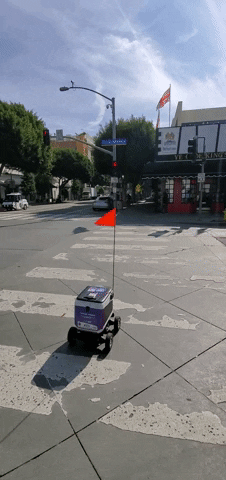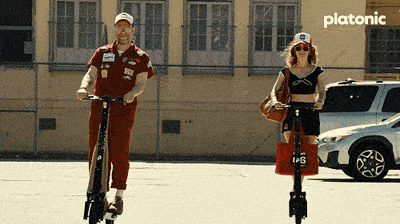- The Scarlet Letter
- Posts
- 1000 Robot Delivers a Day
1000 Robot Delivers a Day
Why only two scooters, Back to work

Are you interested in sponsoring the best local newsletter on the planet? Reply to this email to help your organization reach hundreds of thousands of engaged Columbusites.
Top of Mind
The Rise of the Rovers
Ohio State’s Fleet of Food Bots Rolls Into the Future
Five years ago, students at Ohio State were scrambling for hand sanitizer and trying to figure out Zoom. Now? They're ordering lunch from a 200-pound robot with blinking eyes.
Since launching a pilot in 2021, Ohio State’s robot food delivery program has gone full throttle. There are now 105 autonomous delivery rovers zipping across campus, completing over 1,000 deliveries a day, with a record of 1,373 in one day alone. Operated via GrubHub and maintained in a retrofitted Barnes & Noble near the Tuttle Garage, the fleet is part of a growing trend in campus dining: give students what they want, when they want it — and don't make them talk to anyone.

These rolling snack shuttles cost $2.50 per delivery, a fraction of the price of other apps, and they only use sidewalks, keeping foot and car traffic a little less chaotic (in theory). Most deliveries take about 30 minutes, and yes, students have definitely tried to ride them.The robots are currently bound to campus proper, avoiding busy roads like High Street and Lane Avenue, but future plans include expanding to West Campus, and even drones. The latest model, made by Austin-based Avride, is fully autonomous, snow- and rain-ready, and able to haul six pizzas and a few 2-liters at once. They travel 5 mph, flash heart-eyes on Valentine’s Day, and chant “Go Buckeyes!” during big games.
And while this isn't exactly the kind of eye contact and hospitality OSU dining staff were taught in the ’90s, it’s still service with a smile, even if it’s digital.

photo by Columbus dispatch
Scarlet Letter Trivia
Question: in August onlyincbus did a very well designed post about a boatload of scooters being pulled out of the Scioto, how many scooters were rescued?
A) 100
B) 30
C) 69
D) 4
Scoot Over: Why Columbus Gave the Boot to Lime, Bird, and CoGo

Last week, we told you all about the shiny new fleet of Veo scooters and e-bikes hitting Columbus streets. This week, we’re answering the obvious follow-up: what happened to the rest of them?
If you’ve been wondering why your favorite scooter disappeared from the sidewalk—or why your usual CoGo bike vanished overnight, it’s not just you. Columbus is officially trading in its scattered, multi-vendor scooter chaos for a more controlled (and slightly more polite) system.
The city’s new shared mobility program, which rolled out this weekend, hands the keys to Veo, a single vendor offering e-scooters, e-bikes, pedal bikes, and the Cadillac of personal transport: seated scooters. It’s part of a broader mobility overhaul that aims to improve service, cut clutter, and make the system more accessible for everyone—from college students to commuters to residents with mobility needs.
But not everyone’s riding off into the sunset...
Lime, which once dominated local scooter rides, is not thrilled about being phased out. After being told to pack up their scooters, Lime fired off a statement casting doubt on the city’s claim that Veo’s docked system will fix the problem of scooters blocking sidewalks and ADA ramps. Translation: “We don’t think Veo is the hero Columbus thinks it is, and we’d really like to come back.”
City Councilmember Lourdes Barroso de Padilla disagrees. She says Veo’s system was chosen specifically to improve reliability, expand options, and reduce chaos. And she’s not wrong, under the new plan, Veo’s scooters must be returned to a designated dock or corral, unlike the free-range scooters that once roamed High Street like confused pigeons.
Still, this change wasn’t just about parking etiquette. Columbus wanted better customer service, more inclusive vehicle types, and a system that could scale. That meant consolidating vendors, and Veo won. Spin, which lost the bid and then sued, now gets to stay too, thanks to a settlement that lets them operate under the same terms. Bird? Gone. CoGo? Retired. Lime? Holding out hope for a reboot.

Cya later Lime! In my opinion you were ugliest scooter.
By mid-April, up to 4,000 total devices (half of them seated) could be zipping around the city. Until then, we’re in scooter transition mode, so yes, that weird two-week stretch where no bikes show up on your app is very real.
We’ll see if this reboot brings smoother rides or just a new kind of bump in the road. But one thing’s for sure: Columbus is betting big on micromobility. And this time, it’s a smaller party.
March 11 Marks Five Years Since COVID Shut Down the World. JPMorgan Just Marked the Occasion by Calling Everyone Back to the Office.
In March 2020, everything stopped. Offices emptied. Zoom links replaced meeting rooms. “You’re on mute” became a national catchphrase. And now, five years later to the day, the country’s largest bank is making one thing clear: playtime is over.
JPMorgan Chase, the largest private employer in central Ohio, has officially ordered its 18,600 local employees back to the office, full-time, no exceptions. That includes all 12,000 workers at the company’s massive Polaris campus, a sprawling site that now comes with a free shuttle system to help solve its newest problem: not enough parking for all those returning cars.
CEO Jamie Dimon has long grumbled about hybrid schedules, arguing that mentorship, creativity, and “execution” happen best face-to-face. Now he’s backing that up with policy. While some of his employees say they're still figuring out how to carpool, squeeze into lunch lines, or even find a quiet place to work (hello, open office layouts), the message is clear: if you're not into being back, JPMorgan might not be into keeping you.

Oprah
This return-to-office wave isn’t unique. State workers are heading back too, after Governor DeWine ordered all agencies to reopen by March 17. Downtown Columbus businesses, the ones that watched their lunch crowds vanish in 2020, are thrilled. Some workers, not so much.
So... Are We “Back to Normal”?
That depends on your definition. The pandemic may no longer lead every newscast, but its fingerprints are still everywhere.
Remote work hasn’t vanished, it’s just retreated to certain industries. Hybrid schedules are now a battleground between management and workers. Healthcare systems are still navigating burnout and staffing shortages. Restaurants run on thinner margins. Childcare is more expensive. Mental health services are booked out for months.
And while downtowns are slowly coming back to life, foot traffic, transit use, and office occupancy still trail behind 2019 levels in many cities.

Gif by theoffice on Giphy
Five years ago this week, the NBA shut down mid-game, Tom Hanks tested positive, and millions of Americans realized, all at once, that life wasn’t going back to normal anytime soon.
Now, it seems, we’re settling into a new version of normal: more flexible, more fragmented, and maybe just a little more fragile. But if nothing else, it’s clear that the past five years weren’t just a blip, they rewired how and where we work. And for cities like Columbus, the question isn't just who's coming back to the office, it's what kind of future they're walking into.
Trivia Answer:
B) 30 scooters! We cant wait to see where y’all hide these cool new two seaters!




